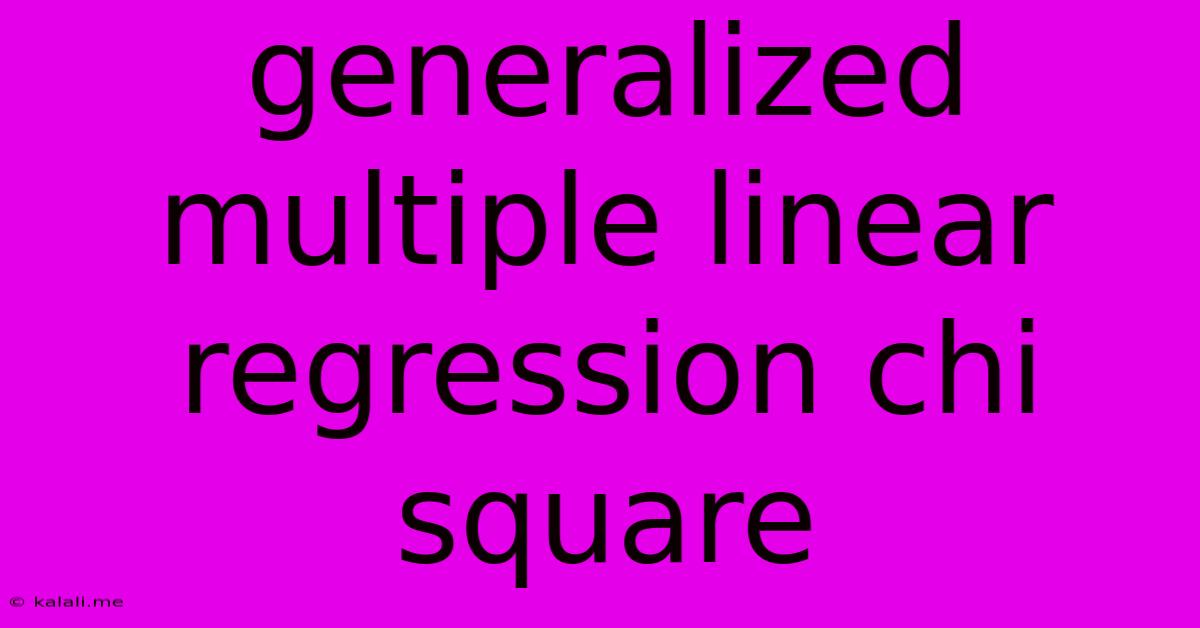Generalized Multiple Linear Regression Chi Square
Kalali
Jun 06, 2025 · 3 min read

Table of Contents
Generalized Multiple Linear Regression and the Chi-Square Test: Unveiling Relationships in Complex Data
Understanding the relationships between multiple independent variables and a dependent variable is crucial in many fields. While multiple linear regression is a common approach, its assumptions can be restrictive. This article explores the use of generalized multiple linear regression (GMLR) and how the chi-square test can play a vital role in assessing its goodness-of-fit and model assumptions. We'll delve into the scenarios where GMLR is preferred, its advantages over traditional linear regression, and how the chi-square test helps validate the model's performance.
What is Generalized Multiple Linear Regression?
Multiple linear regression models the relationship between a continuous dependent variable and two or more independent variables. However, it assumes a linear relationship, normally distributed residuals, and constant variance (homoscedasticity). Generalized multiple linear regression relaxes these assumptions, making it applicable to a broader range of data. GMLR encompasses various models, including:
- Poisson Regression: Suitable for count data (e.g., number of accidents, website visits).
- Logistic Regression: Used for binary or categorical dependent variables (e.g., success/failure, disease presence/absence).
- Gamma Regression: Appropriate for positive, skewed continuous data (e.g., income, waiting times).
The choice of GMLR model depends on the nature of the dependent variable and the underlying data distribution. Unlike traditional multiple linear regression, GMLR uses link functions to model the relationship between the independent variables and the transformed dependent variable. This allows for non-linear relationships.
The Role of the Chi-Square Test
The chi-square test isn't directly used within the GMLR estimation process itself (that usually involves maximum likelihood estimation). However, it plays a crucial role in assessing the model's goodness-of-fit and verifying assumptions:
-
Goodness-of-Fit Tests: While not a direct application of the chi-square test itself within the model, some goodness-of-fit tests for generalized linear models use chi-square distributions to assess how well the model fits the observed data. These tests often compare observed and expected frequencies based on the model's predictions. A significant chi-square statistic suggests a poor fit.
-
Testing for Independence: Before applying GMLR, it's essential to check for independence among the independent variables. A chi-square test of independence can assess whether there are significant associations between pairs of independent variables. High correlation between predictors can lead to multicollinearity, affecting model stability and interpretation.
-
Assessing Categorical Predictors: If your independent variables include categorical data, you might use a chi-square test to evaluate the relationship between the categorical predictors and the dependent variable. This could inform whether these variables should be included in the model. For example, a chi-square test of association between a categorical predictor and a categorical dependent variable (dichotomized from a continuous dependent variable if necessary) can assess potential effects.
Advantages of GMLR over Traditional Multiple Linear Regression
- Flexibility: Handles various data types and distributions.
- Robustness: Less sensitive to violations of normality and homoscedasticity assumptions.
- Applicability: Suitable for a wider range of research questions.
Limitations of GMLR
- Model Complexity: Requires careful model selection and interpretation.
- Interpretation: Interpreting coefficients can be more challenging than in linear regression due to the link function.
- Computational Intensity: Can be more computationally intensive than traditional multiple linear regression, especially with large datasets.
Conclusion
Generalized multiple linear regression offers a powerful approach to analyzing complex relationships between variables when the assumptions of traditional linear regression are not met. The chi-square test, while not directly part of the estimation process, plays a critical role in validating the model's assumptions and assessing its goodness-of-fit. By carefully considering the nature of your data and utilizing appropriate statistical tests, researchers can leverage GMLR to gain valuable insights from their datasets. Remember that proper model selection and interpretation are essential for drawing meaningful conclusions.
Latest Posts
Latest Posts
-
Mac Delete Folder In Libraray Operation Not Permitted
Jun 06, 2025
-
When Does Rimuru Become A Human
Jun 06, 2025
-
What Does It Mean When Someone Says Beas
Jun 06, 2025
-
Does Super Glue Work On Plastic
Jun 06, 2025
-
Is It Me Neither Or Me Either
Jun 06, 2025
Related Post
Thank you for visiting our website which covers about Generalized Multiple Linear Regression Chi Square . We hope the information provided has been useful to you. Feel free to contact us if you have any questions or need further assistance. See you next time and don't miss to bookmark.